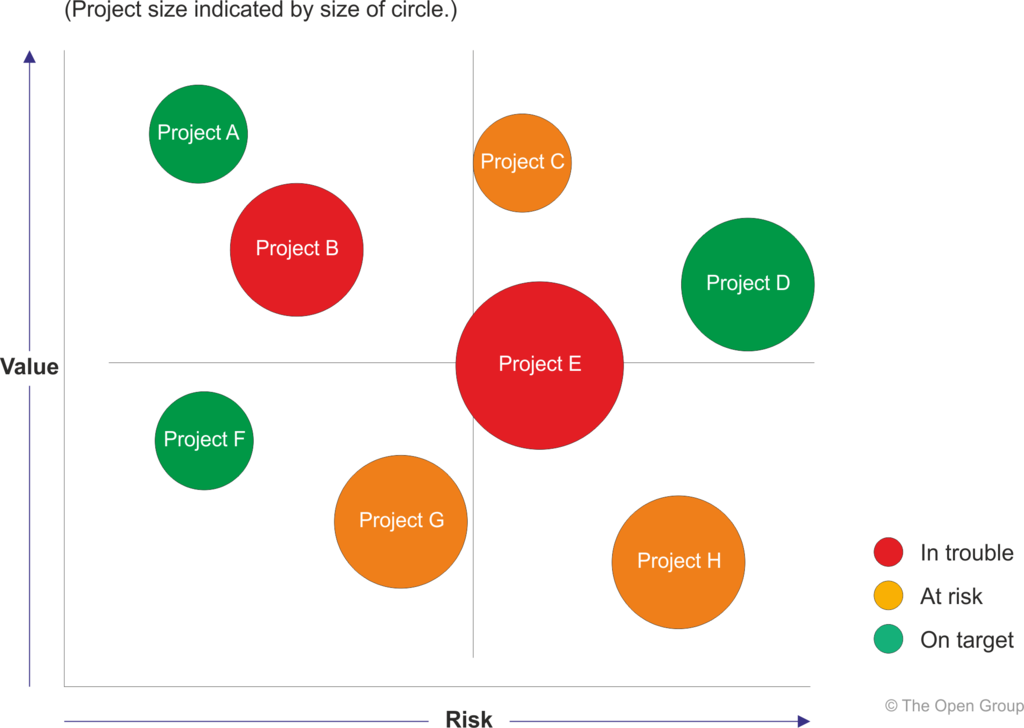Business Value Assessment Technique in the TOGAF Framework
What is the Business Value Assessment Technique?
The Business Value Assessment Technique is a structured approach used to evaluate the potential business value of different projects, initiatives, or investments within an organization. This technique utilizes a matrix that combines a value index and a risk index, allowing decision-makers to assess various options based on their potential benefits and associated risks.
Key Components:
-
Value Index Dimension: This dimension includes criteria that reflect the potential benefits of an initiative, such as:
- Compliance to Principles: How well the initiative adheres to organizational principles and standards.
- Financial Contribution: The expected financial return or cost savings generated by the initiative.
- Strategic Alignment: The degree to which the initiative aligns with the organization’s strategic goals.
- Competitive Position: The potential impact on the organization’s market position relative to competitors.
-
Risk Index Dimension: This dimension includes criteria that evaluate the risks associated with an initiative, such as:
- Size and Complexity: The scale and intricacy of the initiative, which can impact its feasibility.
- Technology: The maturity and reliability of the technology involved.
- Organizational Capacity: The organization’s ability to undertake the initiative in terms of resources and capabilities.
- Impact of Failure: The consequences if the initiative fails, including financial and reputational damage.
Weighting Criteria:
Each criterion within the value and risk indices is assigned a weight based on its importance to the organization. This ensures that the assessment reflects the organization’s priorities and strategic objectives.
Why Use the Business Value Assessment Technique?
1. Informed Decision-Making
The technique provides a structured framework for evaluating options, enabling senior management to make informed decisions based on a clear understanding of potential benefits and risks.
2. Strategic Alignment
By assessing initiatives against strategic criteria, organizations can ensure that their projects align with overarching business goals, enhancing the likelihood of success.
3. Risk Management
The technique helps identify and evaluate risks associated with different initiatives, allowing organizations to proactively address potential challenges before committing resources.
4. Prioritization of Initiatives
Through the use of the value and risk indices, organizations can prioritize initiatives based on their overall business value, ensuring that resources are allocated effectively to the most impactful projects.
How to Implement the Business Value Assessment Technique in TOGAF
Step 1: Define the Value and Risk Indices
- Identify Criteria: Collaborate with stakeholders to identify the criteria for both the value index and the risk index. Ensure that these criteria reflect the organization’s strategic goals and operational realities.
- Assign Weights: Develop a weighting system for each criterion, reflecting its relative importance. Engage senior management to approve these weights.
Step 2: Develop the Assessment Matrix
- Create the Matrix: Draw up the Business Value Assessment Matrix, plotting the value index against the risk index. Each initiative or project will be evaluated against the defined criteria, allowing for a visual representation of its business value versus risk.
- https://guides.visual-paradigm.com/wp-content/uploads/2024/10/28_sample.png

Step 3: Evaluate Initiatives
- Score Each Criterion: For each initiative, assign scores based on how well it meets each criterion in the value and risk indices.
- Calculate Weighted Scores: Multiply the scores by their corresponding weights to get a weighted score for each criterion. Sum these scores to obtain an overall value and risk assessment for each initiative.
Step 4: Analyze Results
- Plot Initiatives on the Matrix: Position each initiative on the matrix based on its overall business value and risk scores. This visual representation helps stakeholders easily identify high-value, low-risk opportunities.
Step 5: Review and Adjust
- Engage Stakeholders: Present the findings to senior management and relevant stakeholders. Gather feedback and discuss the implications of the assessment.
- Iterate as Necessary: Regularly review and adjust the criteria, weights, and assessment process based on changes in organizational strategy, market dynamics, or project outcomes.
Conclusion
The Business Value Assessment Technique is a vital tool within the TOGAF framework that enables organizations to evaluate projects and initiatives systematically. By combining a value index and a risk index, this technique supports informed decision-making, strategic alignment, and effective risk management.
Implementing this technique ensures that organizations prioritize initiatives that deliver the most significant business value while managing risks, ultimately driving better outcomes in enterprise architecture and business strategy. As organizations continue to navigate complex environments, leveraging structured assessment techniques like this will be increasingly important for achieving success.

